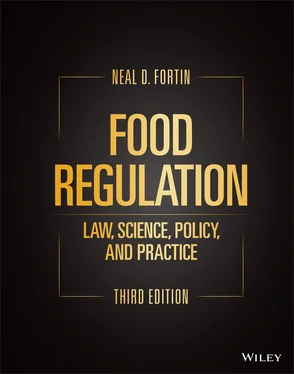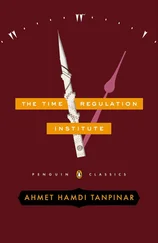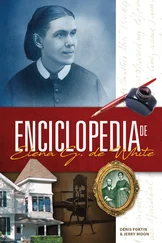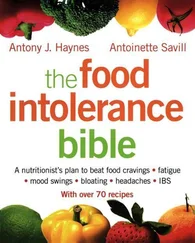Neal D. Fortin - Food Regulation
Здесь есть возможность читать онлайн «Neal D. Fortin - Food Regulation» — ознакомительный отрывок электронной книги совершенно бесплатно, а после прочтения отрывка купить полную версию. В некоторых случаях можно слушать аудио, скачать через торрент в формате fb2 и присутствует краткое содержание. Жанр: unrecognised, на английском языке. Описание произведения, (предисловие) а так же отзывы посетителей доступны на портале библиотеки ЛибКат.
- Название:Food Regulation
- Автор:
- Жанр:
- Год:неизвестен
- ISBN:нет данных
- Рейтинг книги:4 / 5. Голосов: 1
-
Избранное:Добавить в избранное
- Отзывы:
-
Ваша оценка:
- 80
- 1
- 2
- 3
- 4
- 5
Food Regulation: краткое содержание, описание и аннотация
Предлагаем к чтению аннотацию, описание, краткое содержание или предисловие (зависит от того, что написал сам автор книги «Food Regulation»). Если вы не нашли необходимую информацию о книге — напишите в комментариях, мы постараемся отыскать её.
Food Regulation: Law, Science, Policy, and Practice
Food Regulation: Law, Science, Policy, and Practice, Third Edition,
Food Regulation — читать онлайн ознакомительный отрывок
Ниже представлен текст книги, разбитый по страницам. Система сохранения места последней прочитанной страницы, позволяет с удобством читать онлайн бесплатно книгу «Food Regulation», без необходимости каждый раз заново искать на чём Вы остановились. Поставьте закладку, и сможете в любой момент перейти на страницу, на которой закончили чтение.
Интервал:
Закладка:
A NOTE ON STATUTE CITATIONS
All federal statutes in force in the United States are codified into the United States Code (U.S.C.). This codification is an organization of many statutes into a single code, which allows the U.S.C. to be organized by subject matter. For example, most food laws are organized into Title 21 of the U.S.C.
In the course of this organization of the statutes, necessarily section numbering of the acts must be renumbered. For example, section 1 of the FD&C Act is codified as 21 U.S.C. § 301. Thus, you may find this section cited with one or the other or both reference numbers, such as “Sec. 1 [301].”
Citations to the Food, Drug, and Cosmetic Act (FD&C Act) in this book material are to the statute. I also follow with a parallel citation within the brackets to the U.S.C. number. For example, section 1 of the FD&C Act is codified as 21 USC § 301 (Title 21 of the United States Code section 301); thus, I would cite this section as “FD&C Act Sec. 1. [301]”. Nonetheless, occasionally, you will see reference to a U.S.C. citation alone in some of the court decisions.
Most (but not all) of the U.S.C. citations are created by dropping the middle digit and putting a 3 in the hundred’s digit. Thus, FD&C Act Section 401 is codified as 21 U.S.C. § 341. Single‐digit FD&C Act sections become 30×; for example, FD&C Act Section 1 becomes 21 U.S.C. § 301.
FD&C ACT REFERENCES
Free online locations for reference to the FD&C Act include the following:
Cornell’s LII: www.law.cornell.edu/uscode/text/21/chapter‐9
Office of the Law Revision Counsel: http://uscode.house.gov
U.S. Government Printing Office (GPO) Access: www.gpo.gov/fdsys/browse/collectionUScode.action?collectionCode=USCODE
Of course, Westlaw and Lexis‐Nexis provide access to the most up‐to‐date text of the FD&C Act.
DISCUSSION QUESTIONS
The discussion questions within the chapters are designed to encourage thought on the material presented or for class discussion. Some of the questions have neither a right nor wrong answer, particularly those questions that have multiple viewpoints on public policy issues.
PROBLEM EXERCISES
The Problem Exercises are designed to encourage critical thinking. They take on a variety of forms but some are designed to provide practice answering essay questions in food law.
INTERNET CITATIONS
The fluid nature of Internet addresses creates difficulty for a textbook of this nature. The food regulation information available on the Internet is far too valuable not to include some Internet addresses. Inevitably, however, some of these addresses will have changed or the documents will have been removed within days of this book’s printing.
Please realize that learning what types of materials are available is more valuable than finding a specific document. When you find a broken Internet address, take the opportunity to use search engines to find the new location, or to find similar material on the web.
In the types of materials referenced in this text, most of the broken Internet addresses result from reorganization of large document repositories. If search engines cannot find a particular document—and you believe it contains vital information—you may be able to find the document using Internet archives. 1
CITATION FORMAT
Citations in this text generally follow The Bluebook: A Uniform System of Citation (20th Ed.) . However, some conventions are modified to save space and repetition.
I hope you find this text offers an appetizing menu for understanding food regulation in the United States.
ACKNOWLEDGMENTS
It is impossible to write a text of this nature without owing many people a debt of gratitude. I cannot begin to list you all, but extend a thank you to everyone who furthered my scholarship on food law. I also wish to acknowledge my wife, Kathy, and daughter, Helen, who supported me through the many months of writing, without which this book would never have been finished.
The following publishers, journals, and authors are thanked for their generosity in granting permission for me to publish excerpts from the following publications:
Food and Drug Law Institute: Neal Fortin, The Hang‐Up with HACCP: The Resistance to Translating Science into Food Safety Law, 58 FOOD AND DRUG L J 565–594 (2003).
Food Safety News: Richard Raymond and John Munsel, Is AMI’s Hodges Slinging Mud in the Name of Science? FOOD SAFETY NEWS (Feb. 24, 2012).
International Food Information Council: FDA/IFIC, Food Additives (1992).
Journal of Food Law and Policy: Neal D. Fortin, Is a Picture Worth More Than 1,000 Words? 1 J. FOOD L. & POL’Y 239–268 (Fall 2005).
Thompson‐West: James T. O’Reilly, FOOD AND DRUG ADMINISTRATION, 2d Ed. (2004).
NOTE
1 1 For example, the Wayback Machine, which contains 462 billion web pages archived from 1996, http://www.archive.org/web/web.php(last visited Jan. 22, 2016).
ACKNOWLEDGMENTS
It is impossible to write a text of this nature without owing many people a debt of gratitude. I cannot begin to list you all but extend a thank you to everyone who furthered my scholarship on food law. I also wish to acknowledge my wife, Kathy, and daughter, Helen, who supported me through the many months of writing, without which this book would never have been finished.
The following publishers, journals, and authors are thanked for their generosity in granting permission for me to publish excerpts from the following publications:
Food and Drug Law Institute: Neal Fortin, The Hang‐Up with HACCP: The Resistance to Translating Science into Food Safety Law, 58 FOOD AND DRUG LAW JOURNAL 565–594 (2003).
Food Safety News: Richard Raymond and John Munsel, Is AMI’s Hodges Slinging Mud in the Name of Science? FOOD SAFETY NEWS (Feb. 24, 2012).
International Food Information Council: FDA/IFIC, Food Additives (1992).
Journal of Food Law and Policy: Neal Fortin, Is a Picture Worth More than 1,000 Words? 1 JOURNAL OF FOOD LAW AND POLICY 239–268 (Fall 2005).
Thompson‐West: James T. O’Reilly, FOOD AND DRUG ADMINISTRATION, 2d Ed. (2004).
1 INTRODUCTION TO FOOD REGULATION IN THE UNITED STATES
1.1 INTRODUCTION
This chapter provides basic information for students with greatly varied backgrounds. Necessarily, this information may be repetitive or elementary for some readers. Those readers are encouraged to treat this material as a review and refresher. Most of the topics provided in overview in this chapter will be covered later in more depth.
This introduction also provides a historical background that gives insight into the public policy decisions in food regulation. A general explanation of the legal system, regulatory law in general, and the legal basis of food regulation in the United States are included. To enhance an understanding of the legal structures and to simplify its otherwise mysteriousness, this chapter provides an overview of the history of food regulation in the United States. This history accounts for and explains much of the current organization of federal and state regulatory agencies.
This chapter further presents an overview of the major food statutes, regulations, and the jurisdictions of various agencies. This knowledge will allow you to enhance your communication and functioning within this legal framework. In addition, a better understanding of the functions, authority, and interrelationship of various regulatory agencies promotes improved relations with those agencies. This understanding will also improve your ability to function within the regulatory system.
Читать дальшеИнтервал:
Закладка:
Похожие книги на «Food Regulation»
Представляем Вашему вниманию похожие книги на «Food Regulation» списком для выбора. Мы отобрали схожую по названию и смыслу литературу в надежде предоставить читателям больше вариантов отыскать новые, интересные, ещё непрочитанные произведения.
Обсуждение, отзывы о книге «Food Regulation» и просто собственные мнения читателей. Оставьте ваши комментарии, напишите, что Вы думаете о произведении, его смысле или главных героях. Укажите что конкретно понравилось, а что нет, и почему Вы так считаете.












